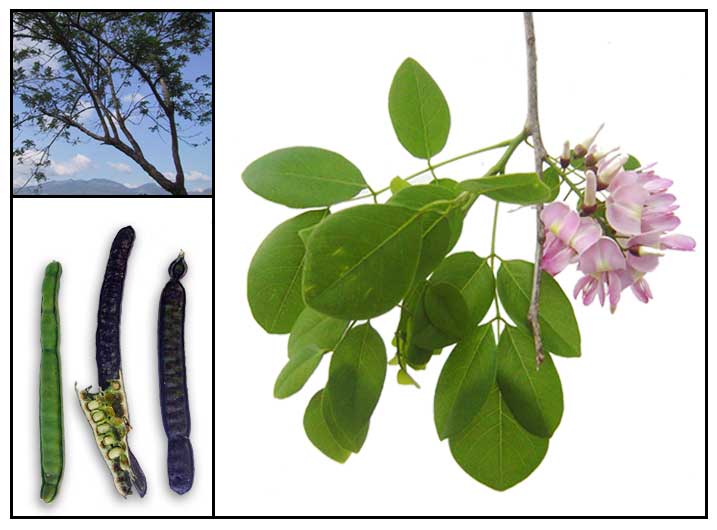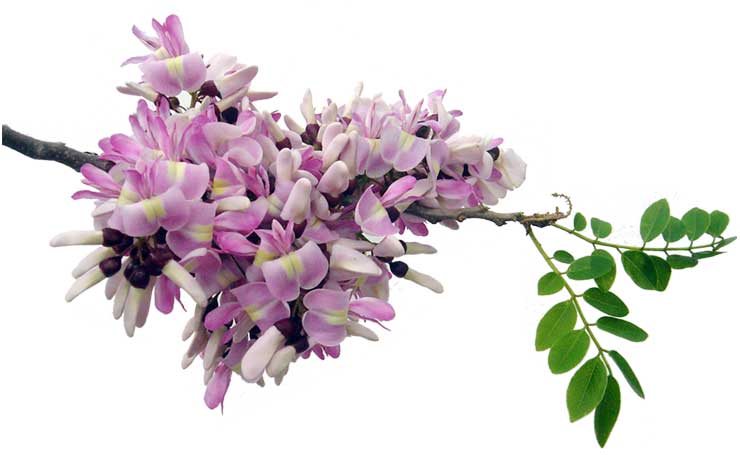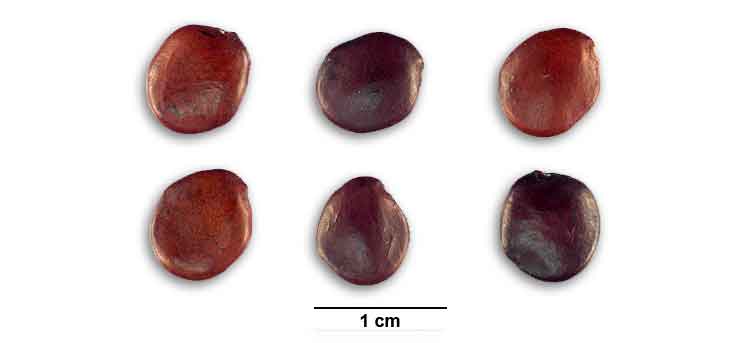|
 Gen info Gen info
The name "gliricidia" derives from the Latin 'glis' (dormouse) and caedere (to kill). The Spanish name "mata-raton" refers to the tree's rodenticial properties.
As the tree pods hang-dry in the sun, they curl and explode, making a popping cracking sound. A cluster of trees with their pods snapping and popping and falling to the ground, in unison, make a fascinating afternoon of nature's concoction of sound.
The tree is common
in the southern Tagalog areas, shedding leaves around December and flowering February and March. In some areas, the blooming of its pink flowers is so profuse to deserve a comparison with the cherry blossoms.
Botany
Kakawati is a smooth, deciduous
tree, 3 to 10 meters high. Leaves are 15 to 25 centimeters long with 13 leaflets which are opposite, oblong-ovate, 4 to 6 centimeters long, with a pointed
tip and rounded base. Racemes are numerous on leafless branches, containing many flowers. Flowers are pink, 2 centimeters long, with a truncate calyx. The standard is reflexed and pale-yellow in the median part. The pods are narrowly oblong to oblanceolate, 10 to 14 centimeters long,
about 2 centimeters wide, containing 6 to 8 seeds.
Distribution
- Thoroughly naturalized throughout the Philippines in settled areas at low and medium altitudes.
- Planted as an ornamental flowering tree for its beautiful pink flowers.
- Introduced by the Spaniards from Mexico.
Constituents
• Phytochemical studies have yielded a formosin (an isoflavan, reportedly with anti-tumor capacity), formononetin, gliricidin-6a-gliricidol-9a, medicarpin (pterocarpan), 7,4'-dihydroxy-3'-methoxyisoflavin, 2'O-methylsepiol, tannin, and a trihydroxyflavone.
• Heartwood yielded a stigmastanol glucoside and 3'4-dihydroxy-trans-cinnamic acid octacosylester 2 along with three other known constituents.
• Study of leaves yielded two new triterpene saponins (1 and 2), possessing 3beta, 21beta, 24--trihydroxy-22-oxoolean-12-ene as aglycon, together with known aromatic compounds. (11)
• Study of bark oil by GC-MS analysis yielded 19 compounds. The major components were methylâ€3(E)â€pentenyl ether (11.55%), 3â€methylâ€2â€butanol (10.65%), 3â€methoxy hexane (10.14%), 1â€(1â€ethoxyethoxy)â€2â€hexene (9.72%), 2†decanol (8.97%), coumarin (8.07%) and hexadecanoic acid (5.16%). (see study below) (17)
• Proximate chemical composition of leaves yielded of bark oil by GC-MS yielded (g/100g DM) 34.5 dry matter, 20.69 crude protein, 23.08 crude fiber, 4.95 ether extract, 7.69 ash, 43.59 nitrogen-free extract, 92.31 organic matter, 48.18 total digestible N, 0.95 Ca, 0.30 P, 0.03 Na, 0.46 Mg, 3.36 K, 21.0 (ppm) Zn, 300 (ppm) Fe, 80 (ppm) Mn, 5 (ppm) Cu, and 4.35 (kcal/g) gross energy. (18)
- GC-FID and GC-MS study of leaves and flowers for essential oil yielded a total of 96 and 109 compounds, respectively, corresponding to 87.9% and 89.2% of total amount of oils. Leaf oil consisted mainly of alipathics (54.9%) and terpenoids (28.1%). Major compounds from the leaf oil were pentadecanal (18.7%), (Z)-phytol (7.8%), methyl linolenate (6.0%) and nonanal (5.1%). Flower oil consisted mainly of
alipathics (58.9%) and terpenoids (25.8%), with major components of hexadecanoic acid (19.7%), myrtenol (7.7%), and (#)-nerolidol (5.9%). Properties
• Tannins are considered potentially antidiarrheal, antidysenteric,
antimutagenic, antioxidant, bactericidal, hepatoprotective, pesticidal
and viricidal.
• Studies have suggested antimicrobial, anti-scabies, nematicidal, insecticidal, antiviral, acaricidal properties.
Parts
utilized
Leaves, bark, roots.
 Uses Uses
Folkloric
- Dermatitis, skin itching:
Apply juice or decoction of leaves, bark or roots on the skin as antipruritic.
- Fresh leaves applied to the skin as insect repellent.
- As counterirritant: Crush leaves and apply as poultice for rheumatic
pains, sprains and closed fractures.
- Sap of bark, leaves and roots have been used for wound healing.
- Treatment of scabies.
- In Guatemala, the bark and leaves are used
to treat skin diseases.
- In Guatemala and Costa Rica, bark decoction is used against bacterial and protozoal infections.
- In many folkloric regimens of other countries, used for headache, bruises,
burns, colds, cough, fever, fatigue, gangrene, gonorrhea, skin itches
and sores; as antidote, insecticide, insect repellent.
- In Panama, decoction of leaves used in urticaria, rash, burns, and erysipelas.
- In some parts of Nigeria, used for the treatment of sickle cell disease. (see study below) (24)
Others
- Wood: Wood is hard and durable
used for small housing needs, posts, implement handles and firewood.
In the Tagalog areas, popularly used as a living fence or live stakes to support plantings.
- Fuel: Used as firewood or source of charcoal. Wood produces a slow burn, without sparking and with little smoke. Calorific value of a 5-year old tree is 4,550 kcal/kg. (28)
- Fleas and ticks: Leaves have a fetid smell; crushed, used to rid dogs of fleas and ticks
and cattle, of ticks. (Also read this blog: Washing Your Dog with Boiled Madre de Cacao Leaves 22)
- Poison: Plant has found application as rodenticide and general pesticide. (read study below: 21) Leaves, seeds, or powdered bark are toxic to humans when mixed with cooked rice or maize. The mechanism of toxicity is not understood. (28)
- Insecticidal, Antifungal, Antiviral: There is some evidence to suggest G. sepium can protect some crops from fungal, insect or viral attack directly or by acting as a diversionary host plant for pets. Studies have also suggested G. sepium mulch has a fungicidal effect. It has been used to control termite damage in Sri Lanka and stem-borer damage to rice in the Philippines. In India, the tree was found to have a positive effect on the transmission of aphids (Aphis craccivora) causing rosette disease in groundnuts. (17) (Also see: 36, 37)
- Insect repellent: In Latin American, used
by farmers to repel insects. Leaves are ground up, mixed with water,
and the resulting paste use to bathe animals, and repeated every 7 to
14 days, decreasing the infections from tropical warble fly.
≠≠≠â‰
- Fodder: Gliricidia sepium has a high nutrient content and great potential for animal feeding.
(18)
- Apiculture: Flowers attract honeybees; hence, an important species for honey production. (28)
 Studies Studies
• Anti-Pseudomonas:
Crude extract of Gliricidium sepium
showed potential anti-pseudomonas drug potential with an in vitro study
showing a minimum inhibitory concentration at 1%. (1)
• Anti-Scabies: A double-blind, randomized, controlled, clinical trial on 44 subjects compared the effectiveness and safety of G. sepium poultice against sulfur lotion as an anti-scabies agent. study concluded that the "kakawati"
preparation is as effective as sulfur lotion in the treatment of scabies. (2)
• Antimicrobial:
Study of 10 medicinal plants in Colombian folk medicine, including G
sepium, was done screening for antimicrobial activity. The ethanol extracts
were all active against S aureus except for J. secunda. (4)
• Antimicrobial: A possible alternative in the treatment of non-nosocomial infections:
G. sepium was one of ten medicinal plants screened for antimicrobial
activity, all of which were found effective against three or more pathogenic
microorganisms, corroborating their use in folkloric medicine.
• Saponins:
Study
yielded three new hederagenin-based acetylated saponins from the fruits
of Gliricidia sepium. (6)
• Insecticidal
/ Nematicidal / Antibacterial: Study
of leaves showed nematicidal activity against Meloidogyne incognita nematode with
60% mortality; mosquito repellent activity against Aedes aegypti with
maximum 78% repellency compared to citronella oil at 74%. Using well diffusion method for antibacterial activity against E. coli,
S aureus, Pseudomonas spp, S typhi and Klebsiella spp, best result was seed
against E Coli. (7)
• Antimicrobial / Bark:
Study
on the antimicrobial activity on the bark of five tree species showed
G sepium to have antimicrobial effects against S epidermis, S aureus,
P aeruginosa, B pumillus and V cholerae. (8)
• Anti-Scabies: In a study of scabies treatment among selected residents of Titay, Zamboanga, results showed a significant difference between pre-treatment and post-treatment scores after one week. However, there was a noted increase of scabies lesions 2 and 4 weeks after. (10)
• Antibacterial / Antifungal: Study investigated an ethanolic extract of Gliricidia sepium for antimicrobial activity against gram-positive, gram-negative bacteria, and fungi. Maximum inhibitory activity was between 0.5 and 1 mg ml-1 against bacteria and 2.5 mg ml-1 against fungi (Fusarium solni, Rhizomucor pusillus, Trichophyton sclerosis, Macrophomnia phaseolina and Rhizoctonia solani). (12)
• Antibacterial / Bark, Flower and Leaf: Study investigated various extracts of bark, flower, and leaf for antibacterial activities against various pathogenic bacteria. Results showed various extracts of flower, bark, and leaves can be used as potential external antiseptic and incorporated into drug formulations. (13)
• Dry Season Feed for Goat Production: Study evaluated the nutritional value of dried G. sepium leaves both fed alone and supplemented with cassava peel in West African dwarf goats. Leaves contained 3.3%N and are available throughout the year. Dried leaves stored throughout the dry season showed no deterioration and can serve as feed reserve. (15)
• Acaricidal / Spider mite / Tetranychus cinnabarinus (Boisduval): The carmine spider mite is an important pest of various economically important crops. Ethanolic extracts showed acaricidal effects and show promise in the management of T. cinnabarinus. (16)
• Antibacterial / Volatile Oil / Bark: The antibacterial activity of essential oil from bark of G. sepium checked against various pathogenic bacteria showed pronounced activity against all tested microorganisms (B. cereus, E. faecalis, S. paratyphi, S. aureus, E. coli, S. faecalis, P. vulgaris, K. pneumonia, P. aeruginosa and S. marcescens). Results suggest a potential use as an external antiseptic. (see constituents above) (17)
• Antioxidant: Study evaluated the antioxidant property of Gliricidia sepium by DPPH radical scavenging assay, NO scavenging assay, super oxide radical scavenging assay and ferrous chelation assay. The plant yielded considerable amount of saponin, phenol, alkaloids, and flavonoids and showed free radical scavenging reducing power and natural chelating property. (19)
• Larvicidal / Mosquito / Leaves: Study evaluated the effectiveness of Madre de Cacao leaf extract as a larvicide for household mosquitoes (Culex pipiens). Results suggest the leaf extract has potential as a natural mosquito larvicide and an alternative substitute to commercial mosquito pesticide. (20) Study evaluated crude extracts (CE) of dried leaves, fresh leaves, dried petioles, and stem bark for toxic properties on late third stage larvae of Anopheles stephansi, Aedes aegypti, and Culex quinquefasciatus. All the crude extracts showed toxicity to the three species of larvae, with 100% mortality at or below a dosage of 16,000 ppm. Mortality rate was dose-dependent. Overall, fresh leaves showed higher toxicity. (27)
• Rodenticidal Mechanism / Coumarins / Leaves: A study reported in 1966 evaluated the mechanism by which G. sepium exerts its rodenticidal properties. Leaf extraction yielded the presence of coumarin as a constituent of the phenolic fraction. Study suggests the bacterial conversion of coumarin into the hemorrhagic agent dicoumerol, and the pathologic evidence in rats fed on incubated leaves point to coumarin as the basis for rodenticidal property of the plant. (21)
• Antisickling /
Leaves: Study evaluated the in-vitro antisickling properties of Gliricidia sepium aqueous leaf extract against haemoglocin SS blood using freshly prepared 2% sodium metabisulphite. Results showed strong antisickling activity: 20% at 5mg, 50% at 10 mg, 80% at 15 mg, and 100% from 20 mg upward of the leaf extract. (24)
• Wound Healing / Sap: Study evaluated the wound healing action of a formulation from the lyophilized sap of G. sepium. The gel formulation was found effective at 7.5% concentration as a wound healing agent. Results suggest a safe, effective, stable, and low cost option as a wound healing agent. (25)
• Antibacterial / Leaves: Study evaluated methanol extracts of G. sepium leaves for antibacterial activity using Fourier transform infrared (FTIR) spectroscopic method. Results showed the ME of GS contained chemical constituents pharmacologically important in the production of antibacterial agents. FTIR spectrum analysis can confirm its presence in the extract and evaluate the qualities of medicinal materials for pharmacologic purposes. (26)
• Herbal Soap Formulation / Adjunct in Treatment of Common Bacterial Skin Infection: A randomized controlled trial of 50 patients in an ER and OPD setting evaluated the efficacy of a herbal soap formulation consisting of Gliciridia septum (Madre de cacao), Plumeria acuminata (kalachuchi) with VCO as an adjunct to Cephalexin in the treatment of common bacterial skin infections in children. Wilconxon rank-sum test showed that patients treated with the Cephalexin and the herbal soap had faster healing of the skin lesions with significantly higher PGA (p<0.0003/day 3, p<0.0001/day 7) compared to with group treated with Cephalexin and hypoallergenic soap. Activity was attributed to herbal soap constituents with antibacterial, anti-inflammatory and moisturizing properties. (•)
• Silver Nanoparticles / Antibacterial:Study reports on the synthesis of silver nanoparticles using Gliricidia sepium. The AgNPs showed antibacterial activity against Staphylococcus aureus, Escherichia coli, Pseudomonas aeruginosa, and Klebsiella pneumonia. The method appears to be cost efficient, ecofriendly and an easy alternative to conventional methods of silver nanoparticles synthesis. (30)
• Anti-Inflammatory / Flowers: Study evaluated the anti-inflammatory activity of aqueous extract of Gliricidia sepium flowers by in-vitro (HRBC membrane stabilization assay) and in-vivo (carrageenan induced paw edema model) model in albino Wistar rats. The extract showed dose-dependent anti-inflammatory activity in human red blood cell membrane stabilization method with diclofenac as standard, and significant percentage inhibition of paw edema. (31)
• Wood as a Source of Dietary Fiber: Study evaluated the addition of wood fiber to wheat flour to produce of bake breads of low caloric value and a high dietary fiber content. In a rat study with feed supplemented with insoluble wood fiber of G. sepium for four weeks, results showed acceptability, without side effects on blood parameters. The incorporation of wood fibers into wheat flour did not adversely affect the physical and baking properties of bread. Results suggest potential for the use of wood of G. sepium as a source of dietary fibers. (33)
• Isolation of Mosquito Larvicidal Compound / Leaves: Study isolated and identified a larvicidal phytochemical from Gliricidia sepum, which is commonly used as smouldering repellent against mosquitoes. The larvicidal activity of various leaf extracts were assayed for toxicity against 4th instar larvae of Culex quinquefasciatus. Bioassay guided fractionation of the leaf extract identified 8,11,14-eicosantrienoic acid as a potential new mosquito-larvicidal compound with LC50 of 0.011 mg/ml and LC90 0.060 mg/ml against 4th instar larvae of Cx. quinquefasciatus. Results suggest potential because of plant ubiquity and easy method of extraction. (34)
• Smoke Repellent Activity / Eicosatrienoic Acid from G. sepium / Filarial Vector Mosquitoes: Study evaluated the effectiveness of 8, 11, 14-eicosatrienoic acid from G. sepium for controlling mosquito. Mosquito coil made using eicosatrienoic acid extracted from G. sepium was fumed for the entire pregnancy period of rat. The fuming study against adult mosquitoes 8, 11, 14-eicosatrienoic acid exhibited high knock-down values KD50, with no toxicity noted to any organs. Results suggest a potential for a plant-based mosquito repellent. (35)
Preparation
for scabies treatment
Courtesy
of: Dr. Joel Bañez, Section of Dermatology, UERMMH
Ingredients:
1. White candlesticks (4)
2. Coconut oil or any cooking oil: 500 cc
3. Kakawati leaves 250 g
Instructions:
1. Clean kakawati leaves thoroughly
2. Chop leaves finely
3. Add 250 g (approximately 1 glass) of finely chopped leaves into 2
glasses of coconut oil.
4. Mix while boiling.
5. Gather leaves on the surface of the oil, then drain using a strainer.
6. Get 4 white candles ('esperma") and chop finely.
7. Add to the boiled preparation and mix until all chopped candles are
melted.
8. Again, using a strainer, drain and transfer mixture into a clean
glass container. Let it cool.
Toxicity
• Tannins:
In South America, in times of scarcity, the forage is fed to livestock.
Although goats can consume large quantities of plants with tannins,
some animals, like cattle and sheep may not tolerate it due to a salivary
protein binding factor that binds the tannins.
Availability
Wild-crafted. |


![]()

